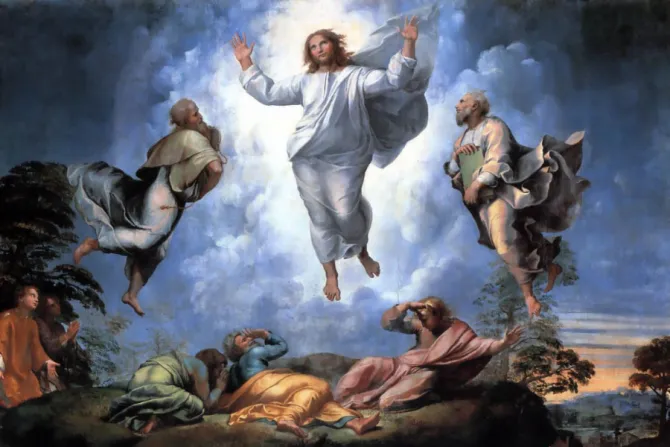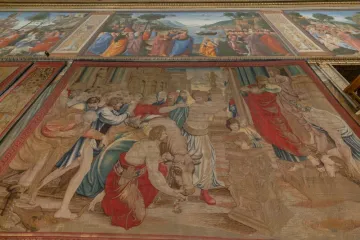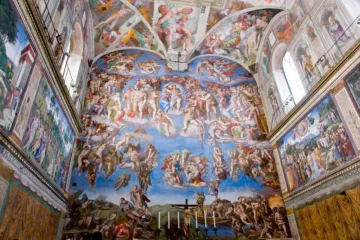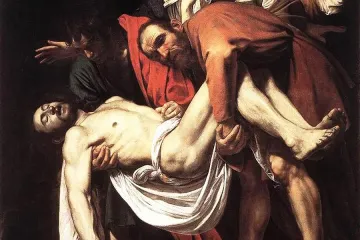Vatican City, Apr 6, 2020 / 11:10 am
Monday, April 6 marks the 500th anniversary of the death of Raphael, the Renaissance painter responsible for "The School of Athens" and "The Transfiguration."
While the Vatican Museums was due to unveil the last phase of restoration of its Raphael Rooms this week, the restored frescoes remain hidden from the public after coronavirus restrictions closed the museums a month ago. However, the Vatican is encouraging people to make virtual museum visits to "admire, even from a distance, the splendor of Raphael's art."
Art historian Elizabeth Lev shared with CNA her advice for Catholics who wish to spend some time contemplating Raphael's works of art during the coronavirus quarantine.
"From his early Oddi altarpiece painted when was about 19 or 20 to the fresco of the School of Athens, to his dazzling tapestries and his architectural feat of a portico decorated with scenes from the Bible, it's easy to understand why Raphael was hailed as an exemplar of 'Catholic excellence,'" Lev said April 6.
"Raphael produced some very powerful altarpieces and, in some cases, even created new types of iconography, especially in the Madonna of Foligno and his St Cecilia panel in Bologna. He reinvented the 'sacred conversation,' which are paintings where saints dialogue with Mary and Jesus, welcoming viewers into greater prayer and contemplation," she said.
The Vatican Museums offer a virtual tour of the Raphael Rooms with a 360 degree view of each room. Raphael was commissioned by Pope Julius II to paint the four rooms in the Apostolic Palace which formed part of the papal apartments.
The School of Athens fresco placing Plato alongside Aristotle can be viewed in the Room of the Segnatura, along with illustrations of the cardinal and theological virtues.
The Room of Constantine was the last of the Raphael Rooms to undergo restoration, a project which began in the 1980s. The virtual tour of the Room of Constantine displays paintings of Constantine's baptism, vision of the cross, and the Battle of the Milvian Bridge before the restoration.
One room in the Vatican Museums' Pinacoteca, or painting gallery, displays Raphael's Crowning of the Virgin, Madonna of Foligno, and The Transfiguration.
"In this very unique week, I would propose reflecting on Raphael's Transfiguration painted just before he died and placed upon his tomb during his funeral," Lev said. "In this work, Raphael paints two distinct areas, the lower section where the apostles attempt to heal a boy possessed by demons (Mark 9:17-29) and then the upper section where Jesus reveals himself to Peter, James and John and God the Father announces 'This is my dearly loved Son. Listen to him.'"
"People are afraid and confused, trying to control things they cannot and struggling pointlessly in the shadows. But lifting one's gaze, one sees Jesus. Everything is subordinate to Him, and he appears as transfigured, a dynamic, powerful light that can repel the encroaching darkness. What an inspiring way for us to envision Jesus during these dark days," she said.
Lev also recommends Raphael's Madonna and Child paintings, such as The Alba Madonna in the National Gallery in Washington, D.C.
"These were small devotional works, meant for contemplation in the home, appropriate for all of us who are housebound," she said. "He did endless variations on them, so there is something for everyone -- versions where Joseph hovers protectively, others where young John and Jesus cavort."
Born Raffaello Sanzio in 1483 in Urbino, Italy, Raphael went on to work in Rome from 1508 to 1520, serving Pope Julius II and Pope Leo X.
Raphael died at the age of 37 on Good Friday, April 6, 1520. He is buried in the Pantheon, which had already been consecrated as the Basilica of St. Mary and the Martyrs, where the artist's tomb remains on display.
"He was brilliant and tremendously successful. When he died at the age of 37 he was already running the equivalent of a Fortune 500 company: the largest studio of the Renaissance," Lev said.
(Story continues below)
Earlier this year, the Vatican Museums displayed 10 of Raphael's tapestries in their original place in Sistine Chapel for one week. The tapestries, commissioned by Pope Leo X in 1515, depict the lives of St. Peter and St. Paul in the Gospels and the Acts of the Apostles.
Raphael painted the Apostolic Palace at the same time as Michaeangelo was working on the Sistine Chapel
"Michelangelo was eight years his senior and was already working in the Sistine chapel when Raphael arrived to paint the apartments of Pope Julius. The two had completely different perspectives on painting. Raphael's was more similar to Leonardo's, with careful backgrounds and elegant compositions, while Michelangelo's figures were sculptural and monumental," Lev explained.
"As these two Titans clashed stylistically, the world's greatest works of art were born," she said.
The Sistine Chapel, the Pio Clementino Museum, the Chiaramonti Museum, the New Wing, the Niccoline Chapel, and the Room of the Chiaroscuri can also be viewed via virtual tour on the Vatican Museums website.
Rome's Scuderie del Quirinale exhibition center had also opened a major exhibition on Raphael this year, which brings together 200 works of art from Louvre, the Uffizi and elsewhere. This exhibition was forced to close 72 hours after its March 5 opening due to the Italian government's closure of all museums in response to the coronavirus outbreak.
A video posted on YouTube by the exhibition center allows quarantined Italians and art lovers around the world to catch a glimpse of the paintings displayed in this exhibition originally scheduled to end June 2.
"Most of us lead very busy lives that were abruptly halted by the quarantines. As we are all required to exercise the virtue of patience these days, we can also rediscover the skill of looking carefully at things, appreciating details and the value of serenity. And nowhere are those qualities better expressed than in the art of Raphael," Lev said.






